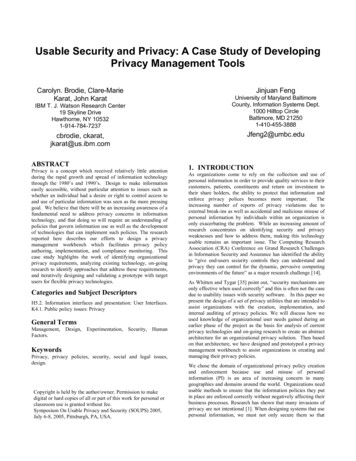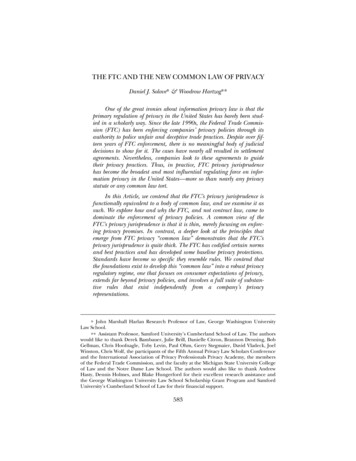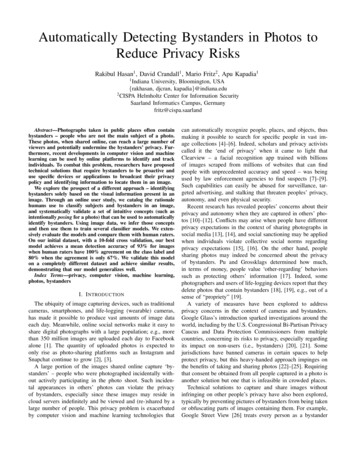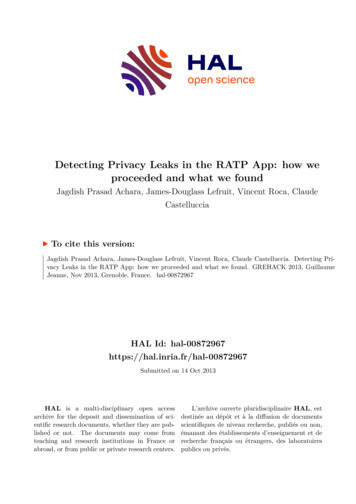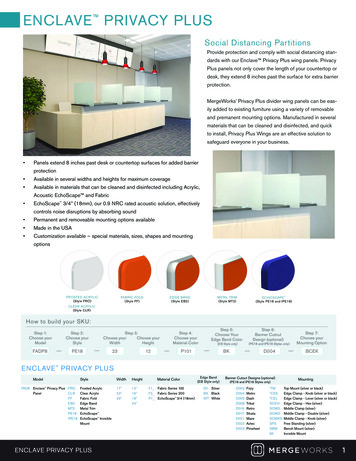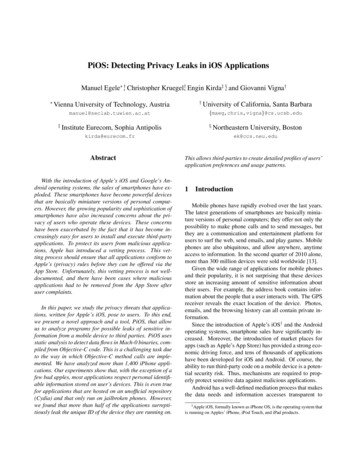
Transcription
PiOS: Detecting Privacy Leaks in iOS ApplicationsManuel Egele †, Christopher Kruegel†, Engin Kirda‡ §, and Giovanni Vigna† †Vienna University of Technology, .tuwien.ac.at‡University of California, Santa Barbara§Institute Eurecom, Sophia AntipolisNortheastern University, Bostonkirda@eurecom.frAbstractWith the introduction of Apple’s iOS and Google’s Android operating systems, the sales of smartphones have exploded. These smartphones have become powerful devicesthat are basically miniature versions of personal computers. However, the growing popularity and sophistication ofsmartphones have also increased concerns about the privacy of users who operate these devices. These concernshave been exacerbated by the fact that it has become increasingly easy for users to install and execute third-partyapplications. To protect its users from malicious applications, Apple has introduced a vetting process. This vetting process should ensure that all applications conform toApple’s (privacy) rules before they can be offered via theApp Store. Unfortunately, this vetting process is not welldocumented, and there have been cases where maliciousapplications had to be removed from the App Store afteruser complaints.In this paper, we study the privacy threats that applications, written for Apple’s iOS, pose to users. To this end,we present a novel approach and a tool, PiOS, that allowus to analyze programs for possible leaks of sensitive information from a mobile device to third parties. PiOS usesstatic analysis to detect data flows in Mach-0 binaries, compiled from Objective-C code. This is a challenging task dueto the way in which Objective-C method calls are implemented. We have analyzed more than 1,400 iPhone applications. Our experiments show that, with the exception of afew bad apples, most applications respect personal identifiable information stored on user’s devices. This is even truefor applications that are hosted on an unofficial repository(Cydia) and that only run on jailbroken phones. However,we found that more than half of the applications surreptitiously leak the unique ID of the device they are running on.ek@ccs.neu.eduThis allows third-parties to create detailed profiles of users’application preferences and usage patterns.1IntroductionMobile phones have rapidly evolved over the last years.The latest generations of smartphones are basically miniature versions of personal computers; they offer not only thepossibility to make phone calls and to send messages, butthey are a communication and entertainment platform forusers to surf the web, send emails, and play games. Mobilephones are also ubiquitous, and allow anywhere, anytimeaccess to information. In the second quarter of 2010 alone,more than 300 million devices were sold worldwide [13].Given the wide range of applications for mobile phonesand their popularity, it is not surprising that these devicesstore an increasing amount of sensitive information abouttheir users. For example, the address book contains information about the people that a user interacts with. The GPSreceiver reveals the exact location of the device. Photos,emails, and the browsing history can all contain private information.Since the introduction of Apple’s iOS1 and the Androidoperating systems, smartphone sales have significantly increased. Moreover, the introduction of market places forapps (such as Apple’s App Store) has provided a strong economic driving force, and tens of thousands of applicationshave been developed for iOS and Android. Of course, theability to run third-party code on a mobile device is a potential security risk. Thus, mechanisms are required to properly protect sensitive data against malicious applications.Android has a well-defined mediation process that makesthe data needs and information accesses transparent to1 Apple iOS, formally known as iPhone OS, is the operating system thatis running on Apples’ iPhone, iPod Touch, and iPad products.
users. With Apple iOS, the situation is different. In principle, there are no technical mechanisms that limit the access that an application has. Instead, users are protected byApple’s developer license agreement [3]. This documentdefines the acceptable terms for access to sensitive data. Animportant rule is that an application is prohibited from transmitting any data unless the user expresses her explicit consent. Moreover, an application can ask for permission onlywhen the data is directly required to implement a certainfunctionality of the application. To enforce the restrictionsset out in the license agreement, Apple has introduced a vetting process.During the vetting process, Apple scrutinizes all applications submitted by third-party developers. If an applicationis determined to be in compliance with the licencing agreement, it is accepted, digitally signed, and made availablethrough the iTunes App Store. It is important to observethat accessing the App Store is the only way for users withunmodified iOS devices to install applications. This ensuresthat only Apple-approved programs can run on iPhones (andother Apple products). To be able to install and executeother applications, it is necessary to “jailbreak” the deviceand disable the check that ensures that only properly signedprograms can run.Unfortunately, the exact details of the vetting processare not known publicly. This makes it difficult to fullytrust third-party applications, and it raises doubts about theproper protection of users’ data. Moreover, there are knowninstances (e.g., [20]) in which a malicious application haspassed the vetting process, only to be removed from theApp Store later when Apple became aware of its offending behavior. For example, in 2009, when Apple realizedthat the applications created by Storm8 harvested usersphone numbers and other personal information, all applications from this developer were removed from the App Store.The goal of the work described in this paper is to automatically analyze iOS applications and to study the threatthey pose to user data. As a side effect, this also shines somelight on the (almost mysterious) vetting process, as we obtain a better understanding of the kinds of information thatiOS applications access without asking the user. To analyzeiOS applications, we developed PiOS, an automated toolthat can identify possible privacy breaches.PiOS uses static analysis to check applications for thepresence of code paths where an application first accessessensitive information and subsequently transmits this information over the network. Since no source code is available, PiOS has to perform its analysis directly on the binaries. While static, binary analysis is already challenging,the work is further complicated by the fact that most iOSapplications are developed in Objective-C.Objective-C is a superset of the C programming language that extends it with object-oriented features. Typi-cal applications make heavy use of objects, and most function calls are actually object method invocations. Moreover,these method invocations are all funneled through a singledispatch (send message) routine. This makes it difficult toobtain a meaningful program control flow graph (CFG) for aprogram. However, a CFG is the starting point required formost other interesting program analysis. Thus, we had todevelop novel techniques to reconstruct meaningful CFGsfor iOS applications. Based on the control flow graphs,we could then perform data flow analysis to identify flowswhere sensitive data might be leaked without asking for userpermission.Using PiOS, we analyzed 825 free applications availableon the iTunes App Store. Moreover, we also examined 582applications offered through the Cydia repository. The Cydia repository is similar to the App Store in that it offers acollection of iOS applications. However, it is not associated with Apple, and hence, can only be used by jailbrokendevices. By checking applications both from the officialApple App Store and Cydia, we can examine whether therisk of privacy leaks increases if unvetted applications areinstalled.The contributions of this paper are as follows: We present a novel approach that is able to automatically create comprehensive CFGs from binaries compiled from Objective-C code. We can then performreachability analysis on these CFGs to identify possible leaks of sensitive information from a mobile deviceto third parties. We describe the prototype implementation of our approach, PiOS, that is able to analyze large bodies ofiPhone applications, and automatically determines ifthese applications leak out any private information. To show the feasibility of our approach, we have analyzed more than 1,400 iPhone applications. Our resultsdemonstrate that a majority of applications leak the device ID. However, with a few notable exceptions, applications do respect personal identifiable information.This is even true for applications that are not vetted byApple.2System OverviewThe goal of PiOS is to detect privacy leaks in applications written for iOS. This makes is necessary to first concretize our notion of a privacy leak. We define as a privacyleak any event in which an iOS application reads sensitivedata from the device and sends this data to a third partywithout the user’s consent. To request the user’s consent,the application displays a message (via the device’s UI) thatspecifies the data item that should be accessed. Moreover,
the user is given the choice of either granting or denying theaccess. When an application does not ask for user permission, it is in direct violation of the iPhone developer program license agreement [3], which mandates that no sensitive data may be transmitted unless the user has expressedher explicit consent.The license agreement also states that an application mayask for access permissions only when the proper functionality of the application depends on the availability of thedata. Unfortunately, this requirement makes it necessary tounderstand the semantics of the application and its intendeduse. Thus, in this paper, we do not consider privacy violations where the user is explicitly asked to grant access todata, but this data is not essential to the program’s functionality.In a next step, we have to decide the types of information that constitute sensitive user data. Turning to the Applelicense agreement is of little help. Unfortunately, the textdoes neither precisely define user data nor enumerate functions that should be considered sensitive. Since the focusof this work is to detect leaks in general, we take a looseapproach and consider a wide variety of data that can beaccessed through the iOS API as being potentially sensitive. In particular, we used the open-source iOS applicationSpyphone [17] as inspiration. The purpose of Spyphone isto demonstrate that a significant number of interesting dataelements (user and device information) is accessible to programs. Since this is exactly the type of information that weare interested in tracking, we consider these data elementsas sensitive. A more detailed overview of sensitive data elements is presented in Section 5.Data flow analysis. The problem of finding privacy leaksin applications can be framed as a data flow problem. Thatis, we can find privacy leaks by identifying data flows frominput functions that access sensitive data (called sources)to functions that transmit this data to third parties (calledsinks). We also need to check that the user is not asked forpermission. Of course, it would be relatively easy to findthe location of functions that interact with the user, for example, by displaying a message box. However, it is morechallenging to automatically determine whether this interaction actually has the intent of warning the user about theaccess to sensitive data. In our approach, we use the following heuristic: Whenever there is any user interactionbetween the point where sensitive information is accessedand the point where this information could be transferred toa third party, we optimistically assume that the purpose ofthis interaction is to properly warn the user.As shown in Figure 1, PiOS performs three steps whenchecking an iOS application for privacy leaks. First, PiOSreconstructs the control flow graph (CFG) of the application. The CFG is the underlying data structure (graph) thatis used to find code paths from sensitive sources to sinks.Normally, a CFG is relatively straightforward to extract,even when only the binary code is available. Unfortunately,the situation is different for iOS applications. This is because almost all iOS programs are developed in ObjectiveC.Objective-C programs typically make heavy use of objects. As a result, most function calls are actually invocations of instance methods. To make matters worse, thesemethod invocations are all performed through an indirectcall of a single dispatch function. Hence, we require novelbinary analysis techniques to resolve method invocations,and to determine which piece of code is eventually invokedby the dispatch routine. For this analysis, we first attemptto reconstruct the class hierarchy and inheritance relationships between Objective-C classes. Then, we use backwardslicing to identify both the arguments and types of the inputparameters to the dispatch routine. This allows us to resolvethe actual target of function calls with good accuracy. Basedon this information, the control flow graph can be built.In the second step, PiOS checks the CFG for the presenceof paths that connect nodes accessing sensitive information(sources) to nodes interacting with the network (sinks). Forthis, the system performs a standard reachability analysis.In the third and final step, PiOS performs data flow analysis along the paths to verify whether sensitive information is indeed flowing from the source to the sink. Thisrequires some special handling for library functions that arenot present in the binary, especially those with a variablenumber of arguments. After the data flow analysis has finished, PiOS reports the source/sink pairs for which it couldconfirm a data flow. These cases constitute privacy leaks.Moreover, the system also outputs the remaining paths forwhich no data flow was found. This information is usefulto be able to focus manual analysis on a few code paths forwhich the static analysis might have missed an actual dataflow.3Background InformationThe goal of this section is to provide the reader with therelevant background information about iOS applications,their Mach-O binary format, and the problems that compiled Objective-C code causes for static binary analysis.The details of the PiOS system are then presented in latersections.3.1Objective-CObjective-C is a strict superset of the C programminglanguage that adds object-oriented features to the basic language. Originally developed at NextStep, Apple and its line
Figure 1. The PiOS system.of operating systems is now the driving force behind thedevelopment of the Objective-C language.The foundation for the object-oriented aspects in the language is the notion of a class. Objective-C supports singleinheritance, where every class has a single superclass. Theclass hierarchy is rooted at the NSObject class. This is themost basic class. Similar to other object-oriented languages,(static) class variables are shared between all instances ofthe same class. Instance variables, on the other hand, arespecific to a single instance. The same holds for class andinstance methods.Protocols and categories. In addition to the featurescommonly found in object-oriented languages, ObjectiveC also defines protocols and categories. Protocols resemble interfaces, and they define sets of optional or mandatorymethods. A class is said to adopt a protocol if it implementsat least all mandatory methods of the protocol. Protocolsthemselves do not provide implementations.Categories resemble aspects, and they are used to extendthe capabilities of existing classes by providing the implementations of additional methods. That is, a category allows a developer to extend an existing class with additionalfunctionality, even without access to the source code of theoriginal class.Message passing. The major difference betweenObjective-C binaries and binaries compiled from otherprogramming languages (such as C or C ) is that, inObjective-C, objects do not call methods of other objectsdirectly or through virtual method tables (vtables). Instead,the interaction between objects is accomplished by sendingmessages. The delivery of these messages is implementedthrough a dynamic dispatch function in the Objective-Cruntime.To send a message to a receiver object, a pointer tothe receiver, the name of the method (the so-called selector; a null-terminated string), and the necessary parametersare passed to the objc msgSend runtime function. Thisfunction is responsible for dynamically resolving and invoking the method that corresponds to the given selector. Tothis end, the objc msgSend function traverses the classhierarchy, starting at the receiver object, trying to locate themethod that corresponds to the selector. This method canbe implemented in either the class itself, or in one of itssuperclasses. Alternatively, the method can also be part ofa category that was previously applied to either the class,or one of its superclasses. If no appropriate method can befound, the runtime returns an “object does not respond toselector” error.Clearly, finding the proper method to invoke is a nontrivial, dynamic process. This makes it challenging to resolve method calls statically. The process is further complicated by the fact that calls are handled by a dispatch function.3.2Mach-O Binary File FormatiOS executables use the Mach-O binary file format,similar to MacOS X. Since many applications for theseplatforms are developed in Objective-C, the Mach-O format supports specific sections, organized in so-called commands, to store additional meta-data about Objective-C programs. For example, the objc classlist section
contains a list of all classes for which there is an implementation in the binary. These are either classes that the developer has implemented or classes that the static linker hasincluded. The objc classref section, on the otherhand, contains references to all classes that are used by theapplication. The implementations of these classes need notbe contained in the binary itself, but may be provided by theruntime framework (the equivalent of dynamically-linkedlibraries). It is the responsibility of the dynamic linker toresolve the references in this section when loading the corresponding library. Further sections include informationabout categories, selectors, or protocols used or referencedby the application.Apple has been developing the Objective-C runtime asan open-source project. Thus, the specific memory layout ofthe involved data structures can be found in the header filesof the Objective-C runtime. By traversing these structuresin the binary (according to the header files), one can reconstruct basic information about the implemented classes. InSection 4.1, we show how we can leverage this informationto build a class hierarchy of the analyzed application.Signatures and encryption. In addition to specific sections that store Objective-C meta-data, the Mach-O fileformat also supports cryptographic signatures and encrypted binaries. Cryptographic signatures are stored inthe LC SIGNATURE INFO command (part of a section).Upon invoking a signed application, the operating system’sloader verifies that the binary has not been modified. This isdone by recalculating the signature and matching it againstthe information stored in the section. If the signatures donot match, the application is terminated.The LC ENCYPTION INFO command contains threefields that indicate whether a binary is encrypted andstore the offset and the size of the encrypted content.When the field cryptid is set, this means that the program is encrypted. In this case, the two remaining fields(cryptoffset and cryptsize) identify the encryptedregion within the binary. When a program is encrypted, theloader tries to retrieve the decryption key from the system’ssecure key chain. If a key is found, the binary is loaded tomemory, and the encrypted region is replaced in memorywith an unencrypted version thereof. If no key is found, theapplication cannot be executed.3.3iOS ApplicationsThe mandatory way to install applications on iOS isthrough Apple’s App Store. This store is typically accessedvia iTunes. Using iTunes, the requested application bundleis downloaded and stored in a zip archive (with an .ipafile extension). This bundle contains the application itself(the binary), data files, such as images, audio tracks, ordatabases, and meta-data related to the purchase.All binaries that are available via the App Store are encrypted and digitally signed by Apple. When an application is synchronized onto the mobile device (iPhone, iPad,or iPod), iTunes extracts the application folder from thearchive (bundle) and stores it on the device. Furthermore,the decryption key for the application is added to the device’s secure key chain. This is required because the application binaries are also stored in encrypted form.As PiOS requires access to the unencrypted binary codefor its analysis, we need to find a way to obtain the decrypted version of a program. Unfortunately, it is notstraightforward to extract the application’s decryption keyfrom the device (and the operating system’s secure keychain). Furthermore, to use these keys, one would also haveto implement the proper decryption routines. Thus, we usean alternative method to obtain the decrypted binary code.Decrypting iOS applications. Apple designed theiPhone platform with the intent to control all software thatis executed on the devices. Thus, the design does not intendto give full system (or root) access to a user. Moreover,only signed binaries can be executed. In particular, theloader will not execute a signed binary without a validsignature from Apple. This ensures that only unmodified,Apple-approved applications are executed on the device.The first step to obtain a decrypted version of an application binary is to lift the restriction that only Apple-approvedsoftware can be executed. To this end, one needs to jailbreak the device2 . The term jailbreaking refers to a technique where a flaw in the iOS operating system is exploitedto unlock the device, thereby obtaining system-level (root)access. With such elevated privileges, it is possible to modify the system loader so that it accepts any signed binary,even if the signature is not from Apple. That is, the loaderwill accept any binary as being valid even if it is equippedwith a self-signed certificate. Note that jailbroken devicesstill have access to the iTunes App Store and can downloadand run Apple-approved applications.One of the benefits of jailbreaking is that the user obtains immediate access to many development tools readyto be installed on iOS, such as a debugger, a disassembler,and even an SSH server. This makes the second step quitestraightforward: The application is launched in the debugger, and a breakpoint is set to the program entry point. Oncethis breakpoint triggers, we know that the system loader hasverified the signature and performed the decryption. Thus,one can dump the memory region that contains the now decrypted code from the address space of the binary.2 In July 2010 the Library of Congress which runs the US CopyrightOffice found that jailbreaking an iPhone is fair use [8].
4Extracting Control Flow Graphs fromObjective-C BinariesUsing the decrypted version of an application binaryas input, PiOS first needs to extract the program’s interprocedural control flow graph (CFG). Nodes in the CFG arebasic blocks. Two nodes connected through an edge indicate a possible flow of control. Basic blocks are continuousinstructions with linear control flow. Thus, a basic block isterminated by either a conditional branch, a jump, a call, orthe end of a function body.Disassembly and initial CFG. In an initial step, we needto disassemble the binary. For this, we chose IDA Pro,arguably the most popular disassembler. IDA Pro alreadyhas built-in support for the Mach-O binary format, and weimplemented our analysis components as plug-ins for theIDA-python interface. Note that while IDA Pro supportsthe Mach-O binary format, it provides only limited additional support to analyze Objective-C binaries: For example, method names are prepended with the name of theclass that implements the method. Similarly, if load orstore instructions operate on instance variables, the memory references are annotated accordingly. Unfortunately,IDA Pro does not resolve the actual targets of calls to theobjc msgSend dispatch function. It only recognizes thecall to the dynamic dispatch function itself. Hence, the resulting CFG is of limited value. The reason is that, to beable to perform a meaningful analysis, it is mandatory tounderstand which method in which class is invoked whenever a message is sent. That is, PiOS needs to resolve, forevery call to the objc msgSend function, what methodin what class would be invoked by the dynamic dispatchfunction during program execution.Section 4.2 describes how PiOS is able to resolve thetargets of calls to the dispatch function. As this processrelies on the class hierarchy of a given application, we firstdiscuss how this class hierarchy can be retrieved from anapplication’s binary.4.1Building a Class HierarchyTo reconstruct the class hierarchy of a program, PiOSparses the sections in the Mach-O file that store basic information about the structure of the classes implementedby the binary. The code of Apple’s Objective-C runtimeis open source, and thus, the exact layout of the involvedstructures can be retrieved from the corresponding headerfiles. This makes the parsing of the binaries easy.To start the analysis, the objc classlist sectioncontains a list of all classes whose implementation is presentin the analyzed binary (that is, all classes implemented bythe developer or included by the static linker). For each ofthese classes, we can extract its type and the type of its superclass. Moreover, the entry for each class contains structures that provide additional information, such as the listof implemented methods and the list of class and instancevariables. Similarly, the Mach-O binary format mandatessections that describe protocols used in the application, andcategories with their implementation details.In principle, the pointers to the superclasses would besufficient to recreate the class hierarchy. However, it is important for subsequent analysis steps to also have information about the available methods for each class, as well asthe instance and class variables. This information is necessary to answer questions such as “does a class C, or any ofits superclasses, implement a given method M?”Obviously, not all classes and types used by an application need to be implemented in the binary itself. That is,additional code could be dynamically linked into an application’s address space at runtime. Fortunately, as the iOSSDK contains the header files describing the APIs (e.g.,classes, methods, protocols, . . . ) accessible to iOS applications, PiOS can parse these header files and extend theclass hierarchy with the additional required information.4.2Resolving Method CallsAs mentioned previously, method calls in ObjectiveC are performed through the dispatch functionobjc msgSend. This function takes a variable numberof arguments (it has a vararg prototype). However, the firstargument always points to the object that receives the message (that is, the called object), while the second argumentholds the selector, a pointer to the name of the method.On the ARM architecture, currently the only architecturesupported by iOS, the first two method parameters arepassed in the registers R0 and R1, respectively. Additionalparameters to the dispatch function, which represent theactual parameters to the method that is invoked, are passedvia registers R2, R3, and the stack.Listing 1 shows a snippet of Objective-C code that initializes a variable of type NSMutableString to thestring “Hello.” This snippet leads to two method invocations (messages). First, a string object is allocated, using thealloc method of the NSMutableString class. Second,this string object is initialized with the static string “Hello.”This is done through the initWithString method.The disassembly in Listing 2 shows that CPU registerR0 is initialized with a pointer to the NSMutableStringclass. This is done by first loading the (fixed) addressoff 31A0 (instruction: 0x266A) and then dereferencingit (0x266E). Similarly, a pointer to the selector (alloc,referenced by address off 3154) is loaded into registerR1. The addresses of the NSMutableString class andthe selector refer to elements in the objc classrefs
and objc selrefs sections, respectively. That is, thedynamic linker will patch in the final addresses at runtime.However, since these addresses are fixed (constant) values,they can be directly resolved during static analysis and associated with the proper classes and methods. Once R0 andR1 are set up, the BLX (branch with link exchange) instruction calls the objc msgSend function in the Objective-Cruntime. The result of the alloc method (which is the address of the newly-created string instance) is saved in register R0.In the next step, the initWithString method iscalled. This time, the method is not calling a static classfunction, but an instance method instead. Thus, the addressof the receiver of the message is not a static address. In contrast, it is the address that the previous alloc function hasreturned, and that is already conveniently stored in the correct register (R0). The only thing that is left to do is to loadR1 with the proper selector (initWithString) a
Using PiOS, we analyzed 825 free applications available on the iTunes App Store. Moreover, we also examined 582 applications offered through the Cydia repository. The Cy-dia repository is similar to the App Store in that it offers a collection of iOS applications. However, it is not associ-ated with Apple, and hence, can only be used by jailbroken

